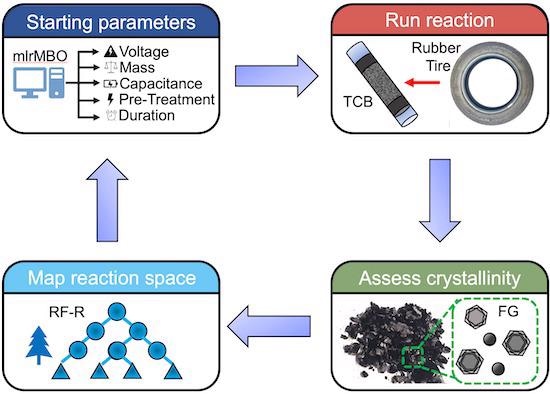Machine-learning techniques have been utilized by the researchers of Rice University to facilitate the process of synthesizing graphene from waste via flash Joule heating.
 Machine learning is fine-tuning Rice University’s flash Joule heating method for making graphene from a variety of carbon sources, including waste materials. Image Credit: Jacob Beckham.
Machine learning is fine-tuning Rice University’s flash Joule heating method for making graphene from a variety of carbon sources, including waste materials. Image Credit: Jacob Beckham.
The discovery of the process was done two years ago by James Tour, a chemist of the Rice lab. It extended beyond making graphene from several carbon sources to removing other materials like metals from urban waste, promising more eco-friendly recycling to come.
The method is considered the same for all of the above: blasting a jolt of high energy via the source material to remove all but the preferred product. However, the details for flashing each feedstock vary from one another.
The scientists explain how machine-learning models, which are capable of adapting to variables and showing them how to optimize procedures, are encouraging them to push forward. The study is published in the journal Advanced Materials.
Machine-learning algorithms will be critical to making the flash process rapid and scalable without negatively affecting the graphene product’s properties.
James Tour, Chemist, Rice University
Tour added, “In the coming years, the flash parameters can vary depending on the feedstock, whether it’s petroleum-based, coal, plastic, household waste or anything else. Depending on the type of graphene we want—small flake, large flake, high turbostratic, level of purity—the machine can discern by itself what parameters to change.”
As flashing makes graphene in hundreds of milliseconds, it is hard to sort out the details of the chemical process. Hence, Tour and company took a hint from materials scientists who have worked machine learning into their daily process of breakthroughs.
It turned out that machine learning and flash Joule heating had really good synergy. Flash Joule heating is a really powerful technique, but it’s difficult to control some of the variables involved, like the rate of current discharge during a reaction.
Jacob Beckham, Study Lead Author and Graduate Student, Rice University
Beckham continued, “And that’s where machine learning can really shine. It’s a great tool for finding relationships between multiple variables, even when it’s impossible to do a complete search of the parameter space.”
“That synergy made it possible to synthesize graphene from scrap material based entirely on the models’ understanding of the Joule heating process. All we had to do was carry out the reaction — which can eventually be automated,” added Beckham.
The lab utilized its custom optimization model to enhance graphene crystallization from four starting materials — plastic pyrolysis ash, carbon black, pyrolyzed rubber tires and coke — in more than 173 trials. This utilizes Raman spectroscopy to characterize the graphene products and starting materials.
Furthermore, the scientists fed over 20,000 spectroscopy results to the model and asked it to anticipate which starting materials would offer the best yield of graphene. Also, the model took the effects of sample mass, charge density and material type into consideration for their calculations.
The co-authors of the study are Rice graduate students Kevin Wyss, Emily McHugh, Paul Advincula and Weiyin Chen; Rice alumnus John Li; and postdoctoral researcher Yunchao Xie and Jian Lin, an associate professor of mechanical and aerospace engineering, at the University of Missouri. Tour is the T.T. and W.F. Chao Chair in Chemistry as well as a professor of computer science and materials science and nanoengineering.
The study was financially supported by the Air Force Office of Scientific Research (FA9550-19- 1-0296), the U.S. Army Corps of Engineers (W912HZ-21-2-0050), and the Department of Energy (DE- FE0031794).
Journal Reference
Beckham, J. L., et al. (2022) Machine Learning Guided Synthesis of Flash Graphene. Advanced Materials. doi.org/10.1002/adma.202106506.